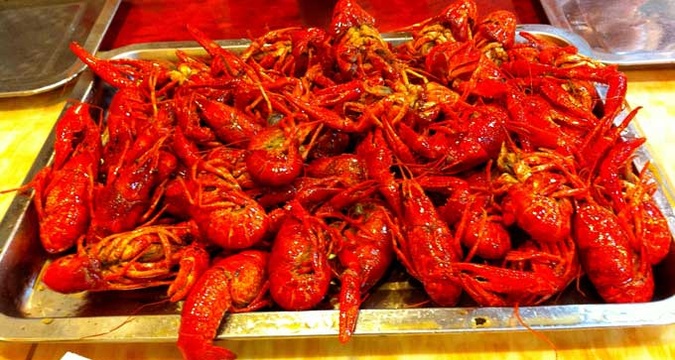Es ist Xiaolongxia Saison.
Flusskrebs – Crayfish – Xiaolongxia – 小龙虾, oder der “kleine Drachen Shrimp”. Aktuell ist Saison. Meine Favorite Locations ist definitiv die Shouning Lu food street. Laut, etwas derb und wild, dafür aber noch ein “echtes” Shanghai Feeling. Die Zubereitung ist meist mala (麻辣) — Xiaolongxia in einer scharfe Chili Soße.

Die Adressen in Shanghai: shanghaiist.com
Es gibt auch unendlich viele Geschichten dazu (timeoutshanghai.com)
‘Xiaolongxia are bugs’
Nope. They’re actually procambarus clarkii, a type of freshwater crayfish. Admittedly, some species of crayfish have been quite aggressive following their introduction to China with reports of them being responsible for devastating rice crops in some parts, but bugs? Hardly.
‘Xiaolongxia only live in polluted waters and feed off of rubbish’
While it’s true that xiaolongxia will eat pretty much anything and can survive in polluted waters, the vast majority of crayfish that find their way to plates in Shanghai have been specially bred for exactly that reason and therefore been given a special diet and living conditions. Few crayfish in China are wild these days.
‘Xiaolongxia feature hundreds of times the standard level of heavy metals in them’
This rumour stems from the strong adaptability of the crayfish and the fact that, as mentioned above, they can survive in heavily polluted environments. Fortunately for us, any toxic substances that they may come into contact with are not absorbed into the body of the crayfish, but instead remain only on their shells and organs (mainly found in their heads). And while they may be tough little creatures, any excess of heavy metals or toxic substances would still mean the end of the unfortunate crayfish that comes into contact with them.
‘Xiaolongxia are a Japanese biochemical weapon’
What do you get when you cross some over-aggressive nationalism with a classic food scare rumour? Why, a totally believable theory that one of Shanghai’s most popular snacks is actually a powerful biochemical weapon manufactured by Japan to undermine China.
This rumour is an off-shoot of a post online that stated that xiaolongxia are the results of genetic engineering undertaken by the Japanese forces during their occupation of parts of China. Due to the number of corpses caused by the invasion, the theory goes, the Japanese created a mutated form of crayfish to help clean the water here. This of course overlooks the fact that the structure of DNA wasn’t discovered until 1953 and that genetic engineering as the direct transfer of DNA from one organism to another wasn’t achieved until 1973.
The tenuous basis for this ridiculous rumour is that crayfish were originally brought to China by the Japanese in the 1930s, a few years after Japan had originally imported them from the US. Incredibly, this rumour gained a fair amount of traction online a few years back, though it’s thankfully been debunked on numerous occasions since. Nevertheless, there’s often a comeback of…
‘Japanese people know where xiaolongxia really come from so they don’t eat them. Most foreigners don’t eat them either’
Despite crayfish becoming widely available in Japan thanks to the US military importing them as a protein supplement, it’s true that many in the country have never really taken to eating them, preferring shrimp instead. But as for the rest of the world, well for starters a quick Baidu of ‘cajun cooking’ ought to shoot down this rumour.
